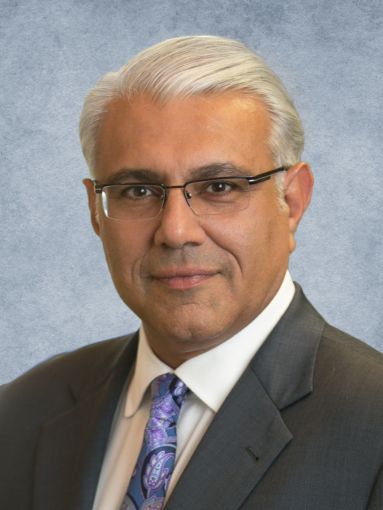Marcus & Millichap CEO Hessam Nadji On Steering The Ship Through Choppy Waters
By Cathy Cunningham September 20, 2022 3:00 pm
reprints
As we approach the fourth quarter, industry leaders are navigating a very different environment than they were 12 months ago. Rising interest rates, inflation and a likely recession have resulted in choppy markets that aren’t for the faint-hearted. But neither was the pandemic period, when some firms showed that they could continue to transact seamlessly, whatever the market threw at them.
Hessam Nadji has been president and CEO of Marcus & Millichap (MMI) for six years, and his tenure at the company dates back almost 27 years, so he’s seen a few market cycles in his time. As a Power L.A. honoree, Nadji chatted with Commercial Observer earlier this month to tell us what he’s prioritizing today, and how Marcus & Millichap is positioned to weather any storms that come its way.
Looking back at the past 12 months, what has kept you busiest?
Hessam Nadji: Marcus & Millichap performed extremely well during the pandemic. Two major factors contributed to this, including our ongoing investments in technology that prevented any downtime and our unique ability to connect buyers and sellers when the transaction market was greatly hampered. In 2021 and the first half of 2022, we set all-time records in sales and earnings as the release of pent-up demand, and our investment in our sales force and their productivity paid off. In 2021 we closed over 13,000 transactions and $84 billion in volume, which translates to more than 50 closings per business day. We are extremely proud of these numbers, but even more so, we are very pleased with our growing client relationships, which are the backbone of these financial results. I spend the majority of time making sure the management team is supporting our existing sales force and clients, setting direction on how we can constantly improve the company, and focusing on strategic growth opportunities that will expand our capabilities. Our clients greatly benefit from the longevity of countless veteran brokers and financing professionals who have grown up with us, as well as a record number of accomplished teams and companies that have joined us over the past few years.
We’re experiencing heightened market volatility today. How are you, as a leader, navigating this period, and is there opportunity to be found amid the choppiness?
The cycle we are facing is truly unusual. Economically, we have two consecutive quarters of GDP contraction, which is one definition of a technical recession, while we have added over 800,000 jobs just in the last two months and over 6 million in the last year. The labor market is hardly in recession, although there are signs of a hiring slowdown and potential layoffs. We all know that the Federal Reserve has no choice but to be aggressive on interest rates and quantitative tightening to fight inflation. The record liquidity injected during the pandemic has created a major challenge in rising prices, exacerbated by global supply chain issues and the unusually tight labor market. This has resulted in the most rapid rise in interest rates in a short period of time in decades, creating volatility in capital markets and causing a repricing of risk and assets.
As a company with over 50 years of cycle experience, we are guiding our team and clients to the long-term benefits of commercial real estate as an investment vehicle. We assure the investment community that this period of uncertainty will pass by showcasing historical data and focusing on what matters the most — understanding investors’ needs and goals and helping them execute. We are the industry’s most effective problem solvers, solution finders, and opportunity creators by combining the art, skill and knowledge of our 2,000 sales and financing professionals with cutting-edge market research. Higher interest rates and the expectation of an economic slowdown are certainly creating a larger bid/ask spread, and there will be price adjustments as the math has changed.
The lack of overbuilding and overleveraging in this cycle and the exceptional strength of the labor market, even if job growth slows to zero or turns negative as the Fed raises rates, bode well for the mid- to long-term outlook for commercial real estate. Our strategy is driven by market share gains, supporting our existing sales force in growing their client outreach and continued talent acquisition. We are fortunate to have a leading market position in a very large and fragmented industry, particularly in the private investor segment.
You’ve been busy expanding Marcus & Millichap’s Institutional Property Advisors (IPA) division this past year, including through the acquisition of Eisendrath Finance Group. What’s the most common need that IPA clients have today?
The addition of Brian [Eisendrath] and his team of financing professionals in IPA Capital Markets was a pivotal move to expand our institutional client services in the multifamily space. Brian and his team have led multifamily origination volume industry-wide for several years, while our IPA multifamily advisory business has become a leading force on the sales side. The integration of capital markets with sales, along with the recent addition of Greg Willett, the best-known housing research professional in the industry, is designed to bring multiple layers of service to our major clients. IPA closed a record $22.2 billion in 2021 with an average deal size of $53.9 million, and $17.9 billion in the first half of 2022 with an average price of $58 million. We are also excited about the success of our IPA retail team, as well as IPA office and industrial. This is a key strategy in diversifying the company’s traditional private investor domination, which Marcus & Millichap is already well known as a category killer. We can connect private and institutional capital and provide the financing, refinancing, and recapitalization of assets and portfolios better than ever.
What’s your take on whether we’ll see a recession next year? How is Marcus & Millichap positioned to weather the storm?
Several variables that could significantly affect recession risk for next year remain in play. Whether the Federal Reserve sustains its aggressive anti-inflation posture and how much they move rates, whether supply chain imbalances improve, and what happens with food and energy prices through the winter months will all have a strong bearing. Most economists are factoring in a relatively high probability of a recession within the next 12 months.
If a recession is in the cards, the commercial real estate sector is generally well positioned. Vacancy rates for most property types are very low, rent growth has been strong, and the risk of overdevelopment is muted. Other than the Global Financial Crisis, past recessions have not caused a significant reduction of commercial real estate transactional activity. Marcus & Millichap maintains a strong balance sheet and has historically outperformed during recessions. Whether the next recession lasts nine months like the 1990 recession or 17 months like the recession in 1981, investors can look to Marcus & Millichap for the best research and transactional guidance available.
In the L.A. market specifically, have you noticed any interesting investment or financing trends of late? What are your clients focused on as we round out the year?
The Los Angeles economy has posted a robust recovery since the depths of the pandemic. In the last 12 months through August, the LA metro added nearly 137,000 jobs. Total employment now lies within 2 percent of pre-pandemic levels. Nonetheless, similar to many other major urban areas, we face numerous economic challenges, including homelessness, impediments to business growth and housing affordability. At the same time, it seems the advantages of this market are often overlooked, including the tremendous draw from a mix of industries, which includes entertainment, tourism, financial service and trade. Some of these industries — particularly trade — may be impeded in the short term, due to the supply chain issues, but fundamentally, a diverse and dynamic economy gives LA a strong foundation.
Commercial real estate mirrors some of these economic strengths and challenges. Overall vacancies are low, and supply is limited across all property types, including office space, which is the most challenged by the hybrid workplace. Apartments remain a bright spot thanks to very low vacancies and strong rent growth, especially in light of 40 percent median home price appreciation over the past two years, and rising interest rates making home purchases much less affordable.
The reinvention of retail is showing up strongly in LA, as tourism and experiential retail make a comeback. Hospitality and self-storage have also shown strong improvement, while industrial warehouse/distribution investment continue to show stellar results for investors, given LA’s importance in global trade and movement of goods and supply-constrained status. Investors’ biggest concern is probably the lack of political direction to address growth impediments, public/private partnership to address the housing shortage and creating incentives for companies to locate and expand here. Over the next five years, the LA metro is expected to add 56,000 people and 229,000 net jobs, despite some of these headwinds.
Are there any personal goals you hope to achieve by year end?
The most urgent focus is to help our sales force keep deals moving forward, expand their client outreach given the rapidly changing market, and execute to the best of their ability despite the market challenges I mentioned before. This is where having brokerage experienced managers leading each of our offices, combined with state-of-the-art technology sets us apart. We also have to keep the company moving forward on a long-term strategic basis while making sure we maximize revenue and earnings in the short term. We have reshaped the company’s leadership team and management lineup over the past five years. This has resulted in the promotion of our best managers to division-level executives.
The C suite has the benefit of two veteran chief operating officers, Richard Matricaria and J.D. Parker; a very experienced chief administrative officer, Greg LaBerge; a new CFO, Steve DeGennaro, with a technology background; chief legal officer, Mark Cortell, with deep M&A experience; a new head of capital markets, Evan Denner; and a new chief marketing officer, Andrew Strockis, who recently joined us from Charles Schwab with extensive digital marketing experience. This team was tested during the pandemic and performed incredibly well and has continued to advance. We are already working on our 2023 plan and priorities, which include reimagining and improving several key initiatives, the next round of technology upgrades, expanding our acquisition targeting, further modernizing our training programs, and making significant progress on diversity and inclusion. As the market becomes more challenging, we will uphold the tradition of being there for clients no matter what. Our financing division, Marcus & Millichap Capital Corporation, is now a major part of how we add value. With nearly 100 capital markets professionals, the team closed deals with over 400 lenders last year, which gives our clients the widest range of capital sources and best terms. We are confident that the integration of financing and investment brokerage, along with our research and advisory capabilities, will help us continue to outperform the market.
Cathy Cunningham can be reached at ccunningham@commercialobserver.com.


